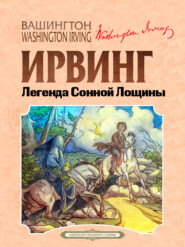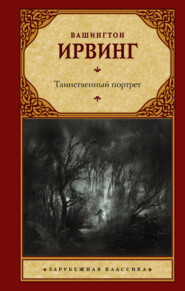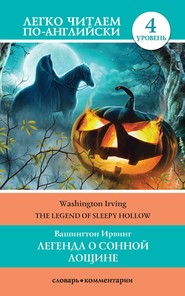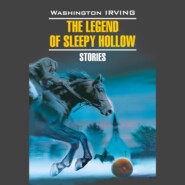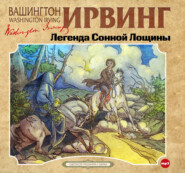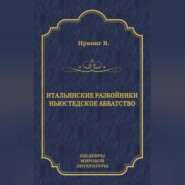По всем вопросам обращайтесь на: info@litportal.ru
(©) 2003-2025.
✖
Abbotsford and Newstead Abbey
Настройки чтения
Размер шрифта
Высота строк
Поля
And expell'd the friars, one friar still
Would not be driven away.
"Though he came in his might, with King Henry's right,
To turn church lands to lay,
With sword in hand, and torch to light
Their walls, if they said nay,
A monk remain'd, unchased, unchain'd,
And he did not seem form'd of clay,
For he's seen in the porch, and he's seen in the church,
Though he is not seen by day.
"And whether for good, or whether for ill,
It is not mine to say;
But still to the house of Amundeville
He abideth night and day.
By the marriage bed of their lords, 'tis said,
He flits on the bridal eve;
And 'tis held as faith, to their bed of death,
He comes – but not to grieve.
"When an heir is born, he is heard to mourn,
And when aught is to befall
That ancient line, in the pale moonshine
He walks from hall to hall.
His form you may trace, but not his face,
'Tis shadow'd by his cowl;
But his eyes may be seen from the folds between,
And they seem of a parted soul.
"But beware! beware of the Black Friar,
He still retains his sway,
For he is yet the church's heir,
Whoever may be the lay.
Amundeville is lord by day,
But the monk is lord by night,
Nor wine nor wassail could raise a vassal
To question that friar's right.
"Say nought to him as he walks the hall,
And he'll say nought to you;
He sweeps along in his dusky pall,
As o'er the grass the dew.
Then gramercy! for the Black Friar;
Heaven sain him! fair or foul,
And whatsoe'er may be his prayer
Let ours be for his soul."
Such is the story of the goblin friar, which, partly through old tradition, and partly through the influence of Lord Byron's rhymes, has become completely established in the Abbey, and threatens to hold possession so long as the old edifice shall endure. Various visitors have either fancied, or pretended to have seen him, and a cousin of Lord Byron, Miss Sally Parkins, is even said to have made a sketch of him from memory. As to the servants at the Abbey, they have become possessed with all kinds of superstitious fancies. The long corridors and Gothic halls, with their ancient portraits and dark figures in armor, are all haunted regions to them; they even fear to sleep alone, and will scarce venture at night on any distant errand about the Abbey unless they go in couples.
Even the magnificent chamber in which I was lodged was subject to the supernatural influences which reigned over the Abbey, and was said to be haunted by "Sir John Byron the Little with the great Beard." The ancient black-looking portrait of this family worthy, which hangs over the door of the great saloon, was said to descend occasionally at midnight from the frame, and walk the rounds of the state apartments. Nay, his visitations were not confined to the night, for a young lady, on a visit to the Abbey some years since, declared that, on passing in broad day by the door of the identical chamber I have described, which stood partly open, she saw Sir John Byron the Little seated by the fireplace, reading out of a great black-letter book. From this circumstance some have been led to suppose that the story of Sir John Byron may be in some measure connected with the mysterious sculptures of the chimney-piece already mentioned; but this has no countenance from the most authentic antiquarians of the Abbey.
For my own part, the moment I learned the wonderful stories and strange suppositions connected with my apartment, it became an imaginary realm to me. As I lay in bed at night and gazed at the mysterious panel-work, where Gothic knight, and Christian dame, and Paynim lover gazed upon me in effigy, I used to weave a thousand fancies concerning them. The great figures in the tapestry, also, were almost animated by the workings of my imagination, and the Vandyke portraits of the cavalier and lady that looked down with pale aspects from the wall, had almost a spectral effect, from their immovable gaze and silent companionship —
"For by dim lights the portraits of the dead
Have something ghastly, desolate, and dread.
– Their buried looks still wave
Along the canvas; their eyes glance like dreams
On ours, as spars within some dusky cave,
But death is mingled in their shadowy beams."
In this way I used to conjure up fictions of the brain, and clothe the objects around me with ideal interest and import, until, as the Abbey clock tolled midnight, I almost looked to see Sir John Byron the Little with the long beard stalk into the room with his book under his arm, and take his seat beside the mysterious chimney-piece.
ANNESLEY HALL
At about three miles' distance from Newstead Abbey, and contiguous to its lands, is situated Annesley Hall, the old family mansion of the Chaworths. The families, like the estates, of the Byrons and Chaworths, were connected in former times, until the fatal duel between their two representatives. The feud, however, which prevailed for a time, promised to be cancelled by the attachment of two youthful hearts. While Lord Byron was yet a boy, he beheld Mary Ann Chaworth, a beautiful girl, and the sole heiress of Annesley. With that susceptibility to female charms, which he evinced almost from childhood, he became almost immediately enamored of her. According to one of his biographers, it would appear that at first their attachment was mutual, yet clandestine. The father of Miss Chaworth was then living, and may have retained somewhat of the family hostility, for we are told that the interviews of Lord Byron and the young lady were private, at a gate which opened from her father's grounds to those of Newstead. However, they were so young at the time that these meetings could not have been regarded as of any importance: they were little more than children in years; but, as Lord Byron says of himself, his feelings were beyond his age.
The passion thus early conceived was blown into a flame, during a six weeks' vacation which he passed with his mother at Nottingham. The father of Miss Chaworth was dead, and she resided with her mother at the old Hall of Annesley. During Byron's minority, the estate of Newstead was let to Lord Grey de Ruthen, but its youthful Lord was always a welcome guest at the Abbey. He would pass days at a time there, and make frequent visits thence to Annesley Hall. His visits were encouraged by Miss Chaworth's mother; she partook of none of the family feud, and probably looked with complacency upon an attachment that might heal old differences and unite two neighboring estates.
The six weeks' vacation passed as a dream amongst the beautiful flowers of Annesley. Byron was scarce fifteen years of age, Mary Chaworth was two years older; but his heart, as I have said, was beyond his age, and his tenderness for her was deep and passionate. These early loves, like the first run of the uncrushed grape, are the sweetest and strongest gushings of the heart, and however they may be superseded by other attachments in after years, the memory will continually recur to them, and fondly dwell upon their recollections.
His love for Miss Chaworth, to use Lord Byron's own expression, was "the romance of the most romantic period of his life," and I think we can trace the effect of it throughout the whole course of his writings, coming up every now and then, like some lurking theme which runs through a complicated piece of music, and links it all in a pervading chain of melody.
How tenderly and mournfully does he recall, in after years, the feelings awakened in his youthful and inexperienced bosom by this impassioned, yet innocent attachment; feelings, he says, lost or hardened in the intercourse of life:
"The love of better things and better days;
The unbounded hope, and heavenly ignorance
Of what is called the world, and the world's ways;
The moments when we gather from a glance
More joy than from all future pride or praise,
Which kindle manhood, but can ne'er entrance
The heart in an existence of its own,
Of which another's bosom is the zone."
Whether this love was really responded to by the object, is uncertain. Byron sometimes speaks as if he had met with kindness in return, at other times lie acknowledges that she never gave 'him reason to believe she loved him. It is probable, however, that at first she experienced some flutterings of the heart. She was of a susceptible age; had as yet formed no other attachments; her lover, though boyish in years, was a man in intellect, a poet in imagination, and had a countenance of remarkable beauty.
With the six weeks' vacation ended this brief romance. Byron returned to school deeply enamored, but if he had really made any impression on Miss Chaworth's heart, it was too slight to stand the test of absence. She was at that age when a female soon changes from the girl to a woman, and leaves her boyish lovers far behind her. While Byron was pursuing his school-boy studies, she was mingling with society, and met with a gentleman of the name of Musters, remarkable, it is said, for manly beauty. A story is told of her having first seen him from the top of Annesley Hall, as he dashed through the park, with hound and horn, taking the lead of the whole field in a fox chase, and that she was struck by the spirit of his appearance, and his admirable horsemanship. Under such favorable auspices, he wooed and won her, and when Lord Byron next met her, he learned to his dismay that she was the affianced bride of another.
With that pride of spirit – which always distinguished him, he controlled his feelings and maintained a serene countenance. He even affected to speak calmly on the subject of her approaching nuptials. "The next time I see you," said he, "I suppose you will be Mrs. Chaworth" (for she was to retain her family name). Her reply was, "I hope so."
I have given these brief details preparatory to a sketch of a visit which I made to the scene of this youthful romance. Annesley Hall I understood was shut up, neglected, and almost in a state of desolation; for Mr. Musters rarely visited it, residing with his family in the neighborhood of Nottingham. I set out for the Hall on horseback, in company with Colonel Wildman, and followed by the great Newfoundland dog Boatswain. In the course of our ride we visited a spot memorable in the love story I have cited. It was the scene of this parting interview between Byron and Miss Chaworth, prior to her marriage. A long ridge of upland advances into the valley of Newstead, like a promontory into a lake, and was formerly crowned by a beautiful grove, a landmark to the neighboring country. The grove and promontory are graphically described by Lord Byron in his "Dream," and an exquisite picture given of himself, and the lovely object of his boyish idolatry —
"I saw two beings to the hues of youth
Standing upon a hill, a gentle hill,
Green, and of mild declivity, the last
As 'twere the cape of a long ridge of such,
Save that there was no sea to lave its base,
But a most living landscape, and the ware
Of woods and cornfields, and the abodes of men.
Scattered at intervals and wreathing smoke
Would not be driven away.
"Though he came in his might, with King Henry's right,
To turn church lands to lay,
With sword in hand, and torch to light
Their walls, if they said nay,
A monk remain'd, unchased, unchain'd,
And he did not seem form'd of clay,
For he's seen in the porch, and he's seen in the church,
Though he is not seen by day.
"And whether for good, or whether for ill,
It is not mine to say;
But still to the house of Amundeville
He abideth night and day.
By the marriage bed of their lords, 'tis said,
He flits on the bridal eve;
And 'tis held as faith, to their bed of death,
He comes – but not to grieve.
"When an heir is born, he is heard to mourn,
And when aught is to befall
That ancient line, in the pale moonshine
He walks from hall to hall.
His form you may trace, but not his face,
'Tis shadow'd by his cowl;
But his eyes may be seen from the folds between,
And they seem of a parted soul.
"But beware! beware of the Black Friar,
He still retains his sway,
For he is yet the church's heir,
Whoever may be the lay.
Amundeville is lord by day,
But the monk is lord by night,
Nor wine nor wassail could raise a vassal
To question that friar's right.
"Say nought to him as he walks the hall,
And he'll say nought to you;
He sweeps along in his dusky pall,
As o'er the grass the dew.
Then gramercy! for the Black Friar;
Heaven sain him! fair or foul,
And whatsoe'er may be his prayer
Let ours be for his soul."
Such is the story of the goblin friar, which, partly through old tradition, and partly through the influence of Lord Byron's rhymes, has become completely established in the Abbey, and threatens to hold possession so long as the old edifice shall endure. Various visitors have either fancied, or pretended to have seen him, and a cousin of Lord Byron, Miss Sally Parkins, is even said to have made a sketch of him from memory. As to the servants at the Abbey, they have become possessed with all kinds of superstitious fancies. The long corridors and Gothic halls, with their ancient portraits and dark figures in armor, are all haunted regions to them; they even fear to sleep alone, and will scarce venture at night on any distant errand about the Abbey unless they go in couples.
Even the magnificent chamber in which I was lodged was subject to the supernatural influences which reigned over the Abbey, and was said to be haunted by "Sir John Byron the Little with the great Beard." The ancient black-looking portrait of this family worthy, which hangs over the door of the great saloon, was said to descend occasionally at midnight from the frame, and walk the rounds of the state apartments. Nay, his visitations were not confined to the night, for a young lady, on a visit to the Abbey some years since, declared that, on passing in broad day by the door of the identical chamber I have described, which stood partly open, she saw Sir John Byron the Little seated by the fireplace, reading out of a great black-letter book. From this circumstance some have been led to suppose that the story of Sir John Byron may be in some measure connected with the mysterious sculptures of the chimney-piece already mentioned; but this has no countenance from the most authentic antiquarians of the Abbey.
For my own part, the moment I learned the wonderful stories and strange suppositions connected with my apartment, it became an imaginary realm to me. As I lay in bed at night and gazed at the mysterious panel-work, where Gothic knight, and Christian dame, and Paynim lover gazed upon me in effigy, I used to weave a thousand fancies concerning them. The great figures in the tapestry, also, were almost animated by the workings of my imagination, and the Vandyke portraits of the cavalier and lady that looked down with pale aspects from the wall, had almost a spectral effect, from their immovable gaze and silent companionship —
"For by dim lights the portraits of the dead
Have something ghastly, desolate, and dread.
– Their buried looks still wave
Along the canvas; their eyes glance like dreams
On ours, as spars within some dusky cave,
But death is mingled in their shadowy beams."
In this way I used to conjure up fictions of the brain, and clothe the objects around me with ideal interest and import, until, as the Abbey clock tolled midnight, I almost looked to see Sir John Byron the Little with the long beard stalk into the room with his book under his arm, and take his seat beside the mysterious chimney-piece.
ANNESLEY HALL
At about three miles' distance from Newstead Abbey, and contiguous to its lands, is situated Annesley Hall, the old family mansion of the Chaworths. The families, like the estates, of the Byrons and Chaworths, were connected in former times, until the fatal duel between their two representatives. The feud, however, which prevailed for a time, promised to be cancelled by the attachment of two youthful hearts. While Lord Byron was yet a boy, he beheld Mary Ann Chaworth, a beautiful girl, and the sole heiress of Annesley. With that susceptibility to female charms, which he evinced almost from childhood, he became almost immediately enamored of her. According to one of his biographers, it would appear that at first their attachment was mutual, yet clandestine. The father of Miss Chaworth was then living, and may have retained somewhat of the family hostility, for we are told that the interviews of Lord Byron and the young lady were private, at a gate which opened from her father's grounds to those of Newstead. However, they were so young at the time that these meetings could not have been regarded as of any importance: they were little more than children in years; but, as Lord Byron says of himself, his feelings were beyond his age.
The passion thus early conceived was blown into a flame, during a six weeks' vacation which he passed with his mother at Nottingham. The father of Miss Chaworth was dead, and she resided with her mother at the old Hall of Annesley. During Byron's minority, the estate of Newstead was let to Lord Grey de Ruthen, but its youthful Lord was always a welcome guest at the Abbey. He would pass days at a time there, and make frequent visits thence to Annesley Hall. His visits were encouraged by Miss Chaworth's mother; she partook of none of the family feud, and probably looked with complacency upon an attachment that might heal old differences and unite two neighboring estates.
The six weeks' vacation passed as a dream amongst the beautiful flowers of Annesley. Byron was scarce fifteen years of age, Mary Chaworth was two years older; but his heart, as I have said, was beyond his age, and his tenderness for her was deep and passionate. These early loves, like the first run of the uncrushed grape, are the sweetest and strongest gushings of the heart, and however they may be superseded by other attachments in after years, the memory will continually recur to them, and fondly dwell upon their recollections.
His love for Miss Chaworth, to use Lord Byron's own expression, was "the romance of the most romantic period of his life," and I think we can trace the effect of it throughout the whole course of his writings, coming up every now and then, like some lurking theme which runs through a complicated piece of music, and links it all in a pervading chain of melody.
How tenderly and mournfully does he recall, in after years, the feelings awakened in his youthful and inexperienced bosom by this impassioned, yet innocent attachment; feelings, he says, lost or hardened in the intercourse of life:
"The love of better things and better days;
The unbounded hope, and heavenly ignorance
Of what is called the world, and the world's ways;
The moments when we gather from a glance
More joy than from all future pride or praise,
Which kindle manhood, but can ne'er entrance
The heart in an existence of its own,
Of which another's bosom is the zone."
Whether this love was really responded to by the object, is uncertain. Byron sometimes speaks as if he had met with kindness in return, at other times lie acknowledges that she never gave 'him reason to believe she loved him. It is probable, however, that at first she experienced some flutterings of the heart. She was of a susceptible age; had as yet formed no other attachments; her lover, though boyish in years, was a man in intellect, a poet in imagination, and had a countenance of remarkable beauty.
With the six weeks' vacation ended this brief romance. Byron returned to school deeply enamored, but if he had really made any impression on Miss Chaworth's heart, it was too slight to stand the test of absence. She was at that age when a female soon changes from the girl to a woman, and leaves her boyish lovers far behind her. While Byron was pursuing his school-boy studies, she was mingling with society, and met with a gentleman of the name of Musters, remarkable, it is said, for manly beauty. A story is told of her having first seen him from the top of Annesley Hall, as he dashed through the park, with hound and horn, taking the lead of the whole field in a fox chase, and that she was struck by the spirit of his appearance, and his admirable horsemanship. Under such favorable auspices, he wooed and won her, and when Lord Byron next met her, he learned to his dismay that she was the affianced bride of another.
With that pride of spirit – which always distinguished him, he controlled his feelings and maintained a serene countenance. He even affected to speak calmly on the subject of her approaching nuptials. "The next time I see you," said he, "I suppose you will be Mrs. Chaworth" (for she was to retain her family name). Her reply was, "I hope so."
I have given these brief details preparatory to a sketch of a visit which I made to the scene of this youthful romance. Annesley Hall I understood was shut up, neglected, and almost in a state of desolation; for Mr. Musters rarely visited it, residing with his family in the neighborhood of Nottingham. I set out for the Hall on horseback, in company with Colonel Wildman, and followed by the great Newfoundland dog Boatswain. In the course of our ride we visited a spot memorable in the love story I have cited. It was the scene of this parting interview between Byron and Miss Chaworth, prior to her marriage. A long ridge of upland advances into the valley of Newstead, like a promontory into a lake, and was formerly crowned by a beautiful grove, a landmark to the neighboring country. The grove and promontory are graphically described by Lord Byron in his "Dream," and an exquisite picture given of himself, and the lovely object of his boyish idolatry —
"I saw two beings to the hues of youth
Standing upon a hill, a gentle hill,
Green, and of mild declivity, the last
As 'twere the cape of a long ridge of such,
Save that there was no sea to lave its base,
But a most living landscape, and the ware
Of woods and cornfields, and the abodes of men.
Scattered at intervals and wreathing smoke






